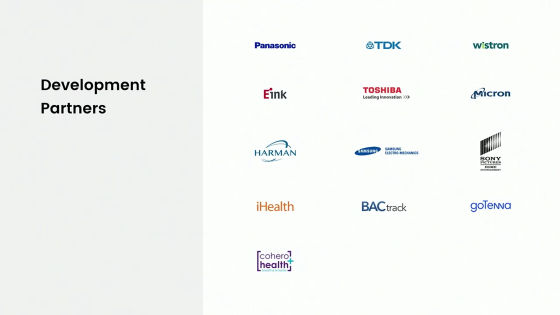Release of developer version of Google's module-interchangeable smartphone "Ara", also decided on marketing time

Modular interchangeable smartphone developed by Google "AraThe latest information onGoogle I / O 2016It was officially announced that it will be released at the ATAP booth and will be released "Developers Edition" for developers later in 2016. Finally, in 2017, we have also decided that a commercial version of Ara Smartphone & Module will be on the market.
Ara
https://atap.google.com/ara/#developers
I can understand what the design of the developer edition of the module interchangeable smartphone "Ara" that appeared at last by looking at the following movie in one shot.
Ara: What's next - YouTube
The back of Ara. It is a traditional prototype, it has changed to a clean design with no frames between the modules.

Each module that can customize the performance of the smartphone can be removed and replaced one touch.

There is also a module with a small liquid crystal display.

Modules seem to be customizable as well as size and color.

You can make your original smartphone that matches your style of intention, such as sticking camera, speaker, battery.

A girl playing a guitar.

It has three speakers and makes it a smartphone specialized for music.

A man looking into the camera's lens.

For camera lovers, it is more convenient for the smartphone lens to be interchangeable.

If it is Ara, you can exchange the lens according to the scene to shoot a single piece.

Because module exchange is one touch, it can be rearranged on the go.

If you carry your favorite module, you can customize the smartphone even on the go.

It seems that the logo of "Ara" has also been confirmed.

How Ara's developer edition works will be described belowGoogle I / O 2016You can check it after 35 minutes of the ATAP presentation movie.
Imagine the possibilities. ATAP. - Google I / O 2016 - YouTube
Developer edition of Ara, first published by Google developer Rafa Camargo.

Camargo takes a camera module in his hand and starts demonstrating, "Let's use it immediately."

"The first step is to install the module"

"The second step is to try it, is not it easy?"

It looks like this shooting with the attached camera module.

Next, demonstrate how to remove the module. "OK, Google. Eject the camera. (OK, Google. Remove camera)" and say ... ...

With the clicking sound, the camera module floated up. Removing the module seems to be done by voice commands.

Mr. Camargo who removed the raised camera module.

I will try to move to the next explanation, but clapping does not stop ringing.

Conventionally, the base part that fixes the module called "Endoskeleton" has been changed to "Ara frame" with SoC, memory, storage, main display, battery and antenna preloaded.

The Ara frame has six module slots and can accommodate up to six modules. Initially, Ara was conceived to be able to exchange all functional modules including SoC, memory, storage, main display, battery etc. However, the basic configuration is fixed to Ara frame, and options such as camera and speaker It has been changed to exchange only the function. Also,"Electro-permanent magnets(Electronic type / permanent magnet) "special pattern fixing method which seems to be canceled.

The module seems to adopt a mechanically removable mechanism called "Springboard" instead of magnetism.

Each module is connected in a power-saving format called "Unipro", and the module is designed to be able to detach more than 1000 times. Also, Ara declares that it supports Type-C USB. Also, "Baseplate" including hardware API dedicated to Ara will be offered to developers.

And Ara's module is open source.

Developers can develop various functional modules such as speakers, cameras and sensors.

There are modules such as sub monitor and LED light.

It is also possible to install a sensor module and transform a smartphone into a measuring instrument.

By combining a number of modules, users can get the original smartphone.

We are promoting module development with major companies and developers such as Panasonic, Toshiba, Micron, Samsung and Sony since 2015. As Ara's developer edition is released, the pace of module development is likely to rise further.

Ara's developer edition will be released in the fourth quarter of 2016.

And Ara's commercial version for general use will be released in 2017.

At the venue of Google I / O 2016,The VergeI am filming the developer edition of Ara.
A closer look at Google's modular phone prototype | The Verge
http://www.theverge.com/google/2016/5/20/11723508/google-project-ara-modular-phone-photos-io-2016
Black color Ara terminal. "ARA" logo is included in the parts including common parts such as SoC, memory and battery at the bottom of the back.

In the module detachable part, you can check "contact" as well as "claw" on both sides.

OS and course Android. Unfortunately, the main display has been changed to non-replaceable.

There is also a physical button on the side.

Because it is divided into a module part and a display part, it has a moderate thickness.

Type - C USB port on the bottom.

It seems to manage modules with "Module Map" application.

Although the release in January 2015 was announced, it was revealed that the modular smart phone "Ara", which had been stopped for information after being postponed twice, was steadily being developed It was. The original plan of all functional module exchange style including display and SoC was changed to a common style with the basic performance part and it changed to a realistic route by mechanically changing the method of fixing the module by the electromagnetic permanent magnet Although it has been changed, it seems that the design will be marketed in a more sophisticated manner, while maintaining customizability that allows you to add or change functions by combining your favorite modules.


Related Posts:
in Video, Hardware, Smartphone, Posted by darkhorse_log






